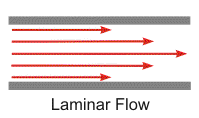 In laminar flow the Navier–Stokes equations describe the momentum transport of flow that is dominated by viscous forces. It is possible with CFD to obtain very accurate flow simulations for single-phase systems, provided that the flow is always laminar. The transitions between laminar and turbulent flow, both from turbulent to laminar and from laminar to turbulent, are difficult to simulate accurately. In this region the flow can fluctuate between laminar and turbulent and turbulent slugs can frequently appear in laminar flow far below the critical Reynolds number for transition to turbulent flow. Simulation of heat transfer is also often very accurate and a good prediction of temperature can easily be obtained.
In laminar flow the Navier–Stokes equations describe the momentum transport of flow that is dominated by viscous forces. It is possible with CFD to obtain very accurate flow simulations for single-phase systems, provided that the flow is always laminar. The transitions between laminar and turbulent flow, both from turbulent to laminar and from laminar to turbulent, are difficult to simulate accurately. In this region the flow can fluctuate between laminar and turbulent and turbulent slugs can frequently appear in laminar flow far below the critical Reynolds number for transition to turbulent flow. Simulation of heat transfer is also often very accurate and a good prediction of temperature can easily be obtained.
Mass transfer in the gas phase is also quite straightforward. However, the diffusivities in liquids are about four orders of magnitude lower than those in the gas phase at atmospheric pressure and accurate mass-transport simulations in laminar liquids are difficult. An estimation of the transport distance due to diffusion in laminar flow can be calculated from x = √ Dt.
The diffusivity in liquids is of the order of 10−9 m2 s −1 and the average transport distance in 1 s is about 3 µm, i.e. very dense grids are required. The corresponding transport distance in the gas phase is 300 µm, with a gas-phase diffusivity of 10−5 m2 s −1 .
